Blepharitis
So far, we have discussed conditions affecting the eyes themselves, but did you know that you can also get an inflammation of the eyelids?
Called blepharitis, this often stems from an imbalance in the composition of the oil and water that the meibomian glands in the inner eyelids produce.
Blepharitis can cause discharge, crusts around the eyes, and pain or irritation.
Stye
Styes are caused by completely-blocked meibomian glands.
Symptoms of styes include a white lump on the rim of your eyelid. The eyelid may be red and painful, and you may have a yellow discharge from the eye as well.
Dry Eyes
Dry eye results when the eyes don't produce enough tears to keep the eyes moist. Dry eyes make the eyes more prone to infection, as tears are what typically remove waste products and wash away impurities.
Dry eyes can be triggered by autoimmune conditions or meibomian gland problems.
The eyes will look red, and there may or may not be a watery discharge as the eyes try to compensate for the lack of tears. Sometimes the patient will experience blurred vision as well.
Contact Lenses
Contact lens wearers tend to have increased discharge from the eyes as a consequence of irritation from the lenses.
It is also possible to get an infection if your contact lens solution is no longer sterile, or if you accidentally transfer bacteria onto the lenses during the cleaning process.
Eye Injury
Eye injuries can involve anything that touches the eye, or gets stuck in the area. Even small particles such as dirt can cause quite a lot of damage.
The eyes will water considerably when it is suffering from injury. This is a protective mechanism, as the eye attempts to flush out the cause of irritation or injury.
Corneal Ulcer
A corneal ulcer is a lesion on the cornea (the front surface of the eye). This is one of the most serious of the complaints discussed here because of its potential to cause permanent vision loss.
The problem is that some of the symptoms such as pain, redness, discharge, and swollen eyelids are indistinguishable from more minor infections. However, with corneal ulcers, the eye discharge is prolific.
Corneal ulcers can be caused by a foreign body in the eye, contact lens irritation, ocular herpes, autoimmune conditions, or allergies.
Dacryocystitis
Dacryocystitis is caused by blocked tear ducts. Symptoms include a painful lump under the inner eyelid, pain, redness, blurred vision and either a sticky or clear discharge.






